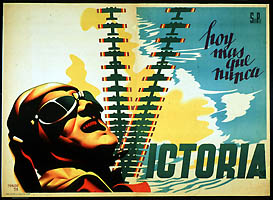 |
Hoy más que nunca, VICTORIA
[Today more than ever, VICTORY]. Signed: Renau, 1938. SubPro. Graf. Ultra, SA, Córcega, 220, Barna. Lithograph, 7 colors; 99 x 138 cm.
|
|
This poster was issued
by the Subsecretaría de Propaganda (Undersecretariat
of Propaganda), an office of the central government which was headed
by the renowned architect Manuel Sánchez Arcas. It was printed
in Barcelona, where the government of the Republic had moved after
leaving Valencia on October 31, 1937. The poster is an homage to
the Republican Air Force, which remained loyal to the government
to a larger degree than other sections of the military after the
rebellion of July 1936. In the image, the planes in the "V"
formation display the flag of the Republic on their wings. This
is different from the red-yellow-red flag of the Spanish monarchy,
which was used before and after the Republic and remains the flag
of Spain to this day. Because of its close relationship with the
Soviet Union, which supplied it with planes and provided training
throughout the war, the Republican Air Force had strong communist
sympathies. The poster may reflect the need to boost morale in Barcelona,
which was heavily bombarded by the Nationalist airforces in the
latter stages of the war.
Born in Valencia in 1907,
Josep Renau was one of the artists most heavily involved in the
Civil War. In 1931 he became a member of the Spanish Communist Party
(PCE), and in 1934 he was arrested for taking part in a revolutionary
strike. On September 7, 1936, he was named Director General of Fine
Arts by a fellow communist, Jes£s Hernández, who was
Minister of Public Instruction in the government of Largo Caballero.
Renau remained in that post until April 1938 and continued to be
involved in the propaganda effort until he left Spain for exile
early in 1939. As Director General of Fine Arts, Renau's duties
included the safeguarding of the artistic heritage of Spain. He
was in charge of evacuating from Madrid to Valencia the paintings
in the Prado Museum, which were threatened by the bombings. He was
also one of the organizers of the Spanish Pavilion in the International
Exhibition held in Paris in 1937, where he was instrumental in securing
Picasso's commission to paint a mural for the pavilion, which resulted
in Guernica. Renau was also an important force behind the conferring
upon Picasso of the largely symbolic appointment as director of
the Prado Museum. During the war, Renau designed numerous posters;
as an artist, he specialized in painting and graphic design, and
gradually became interested in photography. He was successful as
a poster artist in the 1920s, winning numerous prizes and working
on the design of billboards for the film industry.
The gleaming image of
the pilot in this poster may be a reflection of this aspect of Renau's
career. In 1929, he was one of the first artists to use the technique
of photomontage in Spain. He studied the work of John Heartfield,
who became his favorite artist because of his active political stance
and also because he favored photography over the more traditional
medium of painting. On one occasion Renau said, "Yesterday
Goya, today John Heartfield." In 1933, Renau participated in
the first Exhibition of Revolutionary Art held in Madrid (which
included works by other artists present in this exhibition: Monleón,
Rodríguez Luna and PÉrez Mateo). That year he also
founded an important organization of left-wing writers and artists,
the Unión de Escritores y Artistas Proletarios (Union of
Proletarian Writers and Artists). In 1935 he founded and directed
the magazine Nueva Cultura, where in 1936 he published an
important theoretical manifesto entitled The Social Function of
the Advertising Poster. After the war, he was exiled to Mexico and
became a Mexican citizen. He worked with the mural painter Siqueiros,
whom he had met during the war in Madrid, on a mural for the new
building of the Union of Electricians in Mexico City. In 1958 he
moved from Mexico to East Germany. After Franco's death in 1975,
Renau visited Spain periodically. He died in East Berlin in 1982.
|




